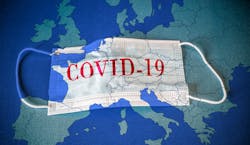Andy Slavitt, Industry Experts Converse On Governors’ Precarious COVID-19 Decisions
As the COVID-19 outbreak continues to spread, hospitals and health systems across the U.S. are probing through various projection models to help them better understand when the surge of infected patients will “peak” in their particular areas. Of course, there’s no foolproof model that exists, and because different analyses produce different outputs for when states might get slammed the most, governors have incredibly difficult decisions to make on a variety of levels.
These pressures being put on state governors are unprecedented for most of them, and the many present-day and forthcoming decisions they will have to make were closely examined during an April 3 webinar hosted by The Commonwealth Fund and the Alliance for Health Policy. The webinar participants were Andy Slavitt, former acting administrator of the Centers for Medicare & Medicaid Services (CMS) and current board chair of the United States of Care; Nirav Shah, M.D., co-founder, CoVidActNow, and senior scholar, Stanford University Clinical Excellence Research Center; and David Radley, Ph.D., senior scientist, tracking health system performance, The Commonwealth Fund.
A core area of discussion among the panelists was that state leaders now have to figure out how to mobilize healthcare resources such as personal protective equipment (PPE) and ventilators, as they are quickly coming to terms with the capacities they have in their respective areas.
But a key challenge, perhaps above all, is that even though most governors are now relying on some sort of projection model to inform them of when patient surges will hit the hardest, there is “an incredible wide range of when that peak date is,” said Slavitt. The reason that’s the case is because the peak date is highly dependent on the infection rate in a given state, which itself is “a moving target because of the built-in lag between symptom onset, hospitalization, and the need for ICU beds and ventilators. So you have a situation where people are having to bet on the future,” Slavitt explained.
Indeed, a range of resources and legislative decisions, as well as different demographics, can lead to divergent outcomes across states. Putting aside the three central COVID-19 “hotspots” right now—New York City, New Orleans, and Detroit—Slavitt said he has spoken to several governors who have said if the curve “flattens” enough—i.e., staggering the number of new cases over a longer period so that the healthcare system isn’t overburdened at any one time—they may be in good shape since the peak date will be in May or June. By that time, states likely won’t be fighting over supplies and ventilators.
At the same time, these same governors have others telling them that the projected peak date is right around the corner, Slavitt said. He recounted an anecdote of one governor being informed by two reliable sources—a university and a prominent foundation that’s considered an expert in this space—of peak dates that were six weeks apart, despite both models using the same information from the state.
Slavitt noted that the cost of predicting the wrong peak date is two-fold: if state leaders underestimate the date, they end up with patients dying in their hallways. If they overestimate the date, patients in another state will suffer.
For example, when it comes to adding more ventilators, in a normal peacetime scenario, governors are able to err on the side of caution, and will add more ventilators than they actually need, just to be safe.
But in the middle of a public health emergency, that decision becomes much tougher since 50 state governors need to make quick and critical decisions on how many ventilators they’ll need, and by which date. Compounding the problem is that no one truly knows when that surge will precisely hit.
From what he’s heard, Slavitt said the Federal Emergency Management Agency (FEMA) is trying to assess states’ needs on a day-by-day basis, but a challenge is that FEMA and governors disagree on how many ventilators a given state will need, with the latter side pushing for more than what the government agency believes to be realistic. Another problem is that in some cases, once COVID-19 patients are placed on a ventilator, they might need to stay on it for two or three weeks. This limits the ability to quickly turnaround a ventilator from one patient to another, resulting in the need for a higher quantity.
Which side is right? Slavitt admitted it’s impossible to know, but one of the consequences of the disagreement is that FEMA “is buying up ventilators left and right,” with the goal to disperse them to the hardest-hit areas. And if certain states want more than what FEMA gives them, they will need to purchase them on the open market, where they are bidding for ventilators from private manufacturers.
“At this point in time, if a state wants to buy a ventilator, they would be paying $45,000 for a $15,000 [product],” said Slavitt, who did offer one silver lining: ventilator production capacity will begin to ramp again in early May, meaning there will be a significant number available in about six weeks. For those states that can push the curve back, this is good news. But, ultimately, “there is a logistics game that needs to be played much better than it has,” Slavitt contended.
What’s more, governors are also wresting with how long they can sustain peoples’ abilities to stay home, Slavitt reported. “They are worried, both sociologically and economically, and they don’t feel like they have the ability to control the answer to that question. Without knowing if they will get more help from the federal government, many governors believe that once it gets to April 30th—the date President Trump has extended the social distancing guidelines to—"they will be facing significant challenges.”
For instance, Slavitt offered, if states have more ramped-up testing in place, as well as contact tracing by the end of the month, they could then reduce the R0 (pronounced R-naught, meaning the average number of people that one sick person goes on to infect). But if they don’t, then the virus will continue to transmit at a dangerous rate. “I don’t think it’s a matter of what scientists tell them versus what economists tell them; it’s a matter of how the manage the situation carefully,” Slavitt attested.
Which data is reliable?
Nirav Shah, M.D., helped launch CoVidActNow, a model that estimates when hospitals will likely become overloaded. While there is no shortage of COVID-19 predictors available, Shah believes there a few core elements needed to evaluate the trustworthiness of a model.
First, explained Shah, does the model reflect reality at a high level? “Are the numbers in the right order of magnitude? Are they moving in the right direction, and are they matching other countries that are ahead of us in the pandemic?” Second, he noted, is the model robust? “Does it make assumptions that are risky? What decisions does it lead us to? What would happen to our decisions if this model was 10, 50 or 90 percent wrong?” Third, he offered, is it transparent? “Can you review it? [Can it be] easily explained or understood, and can you connect with a team to ask those questions?” Fourth, he said, is the model clear about its unknowns and limitations? “Are they open to it changing?” And finally, he said, is it vetted? Have outside experts reviewed and endorsed that model?”
To this end, Shah touted the US Health Weather Map, powered by smart thermometer maker Kinsa, which uses real-time surveillance data that tracks the temperatures of people by using a million smart thermometers at home. The result is being able to record fevers almost as soon as people get them. “These have been some of the best estimates of where COVID-19 is in the community,” he contended. Further, he pointed to Unacast, a social distancing scoreboard that leverages mobility data from GPS signals on cellphones to show folks how effective their shelter-in-place or stay-at-home orders have been. The tool also compares how much people are moving around compared to historical estimates.
However, Shah noted that one key data point that’s been commonly referenced is COVID-19 deaths, which he said is a lagging indicator. “By the time people are dying, it’s too late. So we are relying on the number of people hospitalized in each state, and that is a very good number, but only half the states are reporting [this] on a daily basis. Today, the call of action should be to report out your data transparently so we can understand how your state will be at risk and where you are along the curve,” Shah said.
He also pointed out the lengthy process of data collection, which starts at the public health level, and then moves to the county, to the state, and then up to the CDC, and finally to Johns Hopkins, which has tracked global cases and trends on a daily basis. “So you are looking at delayed data signals. We need much faster, real-time data that is reliable, and that doesn’t exist today,” said Shah.


